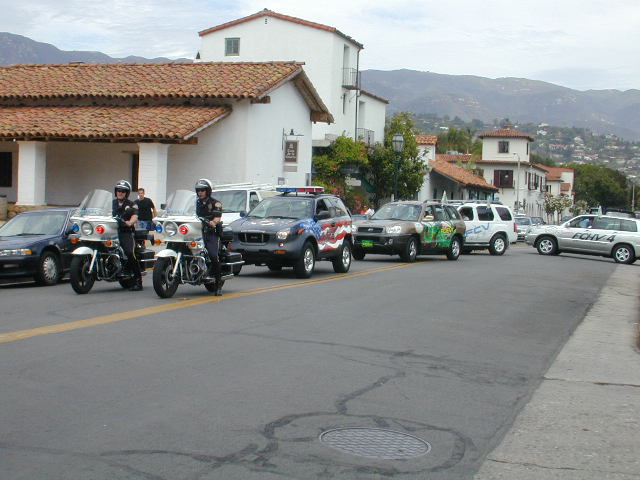
Home - AFV Events - Other AFV Events - CaFCP 2002 Rally

The California Fuel Cell Partnership (CaFCP) is a collaboration between automakers, energy companies, component manufacturers, and California and federal government agencies; its purpose is to prepare the way for commercialization of fuel cell vehicles (FCVs). Based in West Sacramento, CA, they have a growing fleet of FCVs that run on hydrogen either carried in pure form as a compressed gas or generated onboard from methanol or gasoline; they use these to test the vehicles in real-world driving, and to gain experience with different possible methods of refueling them. From September 4th to 6th, 2002, they drove six of their FCVs, all running on compressed hydrogen, on a road rally along the California coast starting at Monterey; on the final day I drove up (in my natural-gas van) to meet them at the finish line in Santa Barbara. The vehicles first halted at De La Guerra Plaza, near the center of town; the photo above is of their departure (since I missed the parade into the city), as they went to a local hotel for a Town Hall Meeting and some test rides.
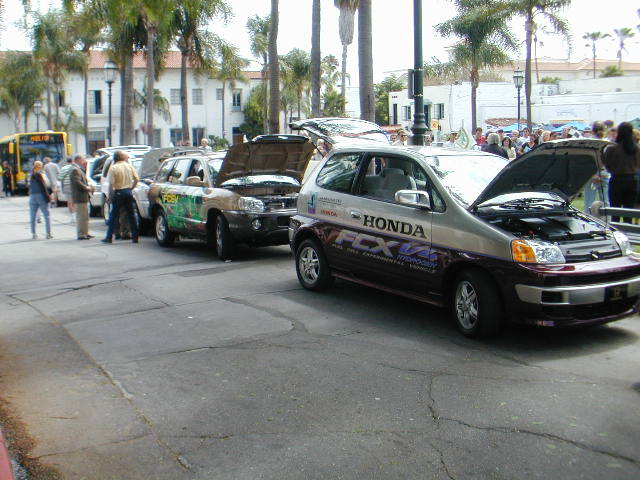
Here are the vehicles lined up at De La Guerra Plaza; Mayor Marty Blum welcomed the drivers and visitors, and proclaimed 6 September 2002 to be Fuel Cell Day in Santa Barbara. In the photo of the parade at top, following the police motorcycles and the D.A.R.E. truck, are the Hyundai, Nissan, and Toyota FCVs; in the foreground of this photo is the Honda FCX-V4, which I last saw at the Los Angeles Auto Show in January. Also present was the Ford Focus FCV; the DaimlerChrysler NECAR 4, based on the subcompact Mercedes A-class (not sold in the USA) arrived at the hotel on a trailer, since it had suffered a mechanical failure on the road (hey, these are prototypes!). You'll note that the Hyundai, Nissan, and Toyota entries are all SUVs, based on the Santa Fe, Xterra, and Highlander respectively. One woman viewing the lineup at De La Guerra Plaza was irritated by this, saying "we should be getting rid of those!" But, as the Hyundai engineer with whom we were talking pointed out, SUVs are precisely the kind of vehicle that can benefit most from the efficiency of a fuel-cell drivetrain.
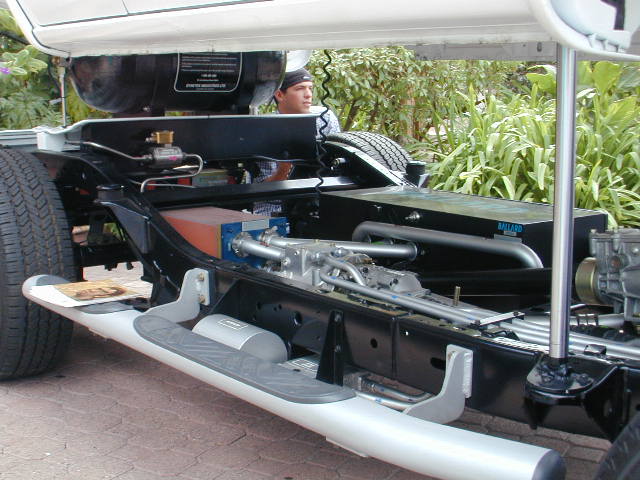
Besides, as with my van and its four fuel tanks, a truck chassis provides more space to mount the components of a nonstandard drivetrain. In addition to the vehicle they drove in the road rally, Nissan also brought one with the body lifted off the chassis for display, so that we could see the components. The large box labeled Ballard, mounted next to the far frame rail, is the fuel cell stack, which converts hydrogen and oxygen to water and extracts the energy of the chemical reaction directly as electricity; the fuel tank is visible behind and above the rear axle. Just inside the near frame rail is the air compressor, which pressurizes the air that supplies the oxygen for the reaction.
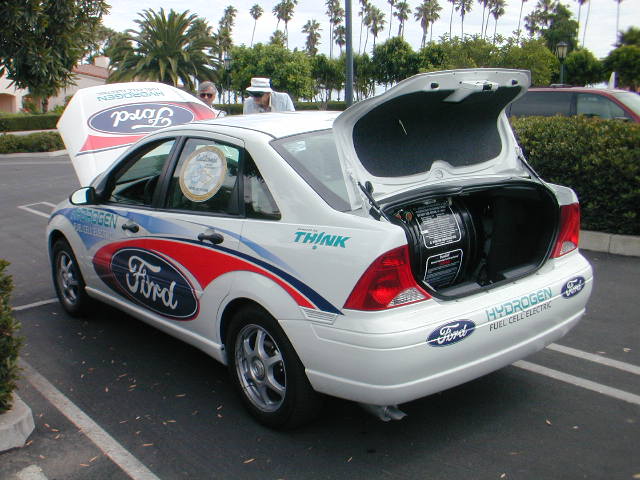
Of course, the DaimlerChrysler and Ford FCVs prove that it is also possible to build such a drivetrain into a compact vehicle! This is the Ford Focus, parked at the hotel waiting for a fill-up; you can see that the trunk is almost completely filled by the fuel tank, though a production vehicle would certainly have better "packaging" than a prototype like this. You'll also notice the label saying "Powered by TH!NK" to the left of the trunk; just weeks before this event, Ford decided to shutter their TH!NK division, halting sales of the TH!NK Neighbor low-speed electric vehicle (EV) and canceling plans to start selling the TH!NK City two-seat commuter EV later this year. The Ford representatives there said that the fuel-cell research effort would continue inside Ford R&D, and the last I heard there are still plans to introduce a limited number of Focus FCVs to fleets in the 2004 model year.
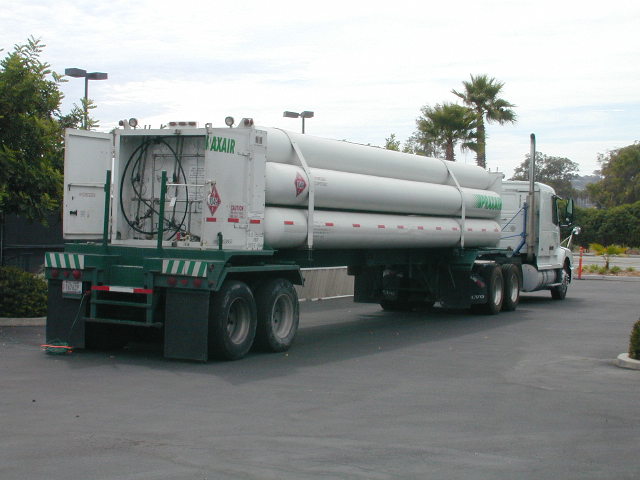
There was one additional, very important vehicle present at the hotel, namely this rig with a trailer full of pressurized hydrogen. This provided either 3600 PSI or 5000 PSI fuel for the vehicles; unlike my journey Clean Across America and Back with my natural-gas van or the Malibu rally of the EV1 Club, drivers on this trip couldn't expect to find public refueling stations enroute! The only one that I know of is at the Sunline location in Thousand Palms, CA, though Ohio has plans to start building some too.

The Town Hall Meeting at the hotel was attended by at least a couple of hundred people. Speaking here is the CaFCP Executive Director, Catherine Dunwoody; to her left is Mayor Blum, and to her right are representatives from various subsets (automakers, government, energy) of the CaFCP participants. After remarks from these folks, and a few short videotapes about fuel cells and the road rally, the audience got a chance to ask questions and make comments. There was general enthusiasm for fuel cells, the partnership, and the achievement represented by the road rally, but it was also clear that we are going to be watching over the next several years to ensure that all participants in the partnership maintain their level of commitment.
I threw out the first question, asking about plans for educating the public about fuel cells and the practicality of this new technology, given the previous failure of, well, anybody to conduct much public education about the practicality of battery-electric vehicles over the past several years. Among other things, I was told that all the stakeholders had participated in drawing up a plan for practical commercialization of FCVs, including the educational component. Since automakers felt (and still feel) that they were force-marched into the EV market, this report is different in that all participants think they can take the plan it outlines and make it work. I am really looking forward to reading this when it is published!
[Note added 29 April 2003: shortly after the rally, I found the report online, under the name Fuel Cells and Hydrogen: The Path Forward. Much to my dismay, I found that it had not been endorsed by any automakers--not one. This appears to be a "live" document, and has been revised at least once since it was first published; in the revision, the federal FreedomCAR program is addressed, and General Motors has signed on. The report definitely emphasizes the need for education and federal support in the form of actual vehicle purchases, but as I said, we will be watching...]
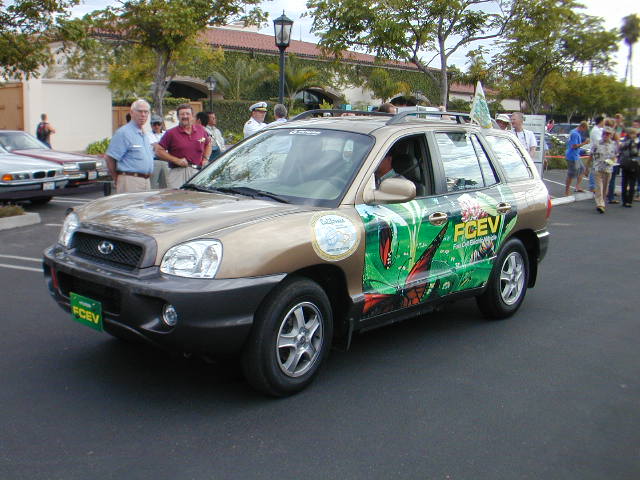
After the meeting we went out to the parking lot, and many people got their first ride in a fuel-cell vehicle! I had to head back to Los Angeles to catch a plane, otherwise I would have waited in line to ride them all; as it was, I got to ride in the Hyundai Santa Fe. This was a working "mule," not a polished concept car; there were computer ports sticking out of the dash, and the engineer driving it said it was missing most of its sound insulation. Despite this, the ride was very quiet and smooth; the only noise that was readily apparent was the hum of a small blower to recirculate unused hydrogen back into the fuel cell stack. Unlike the Nissan drivetrain pictured toward the top of this page, the Hyundai is the first FCV to operate at ambient air pressure, meaning that no noisy air compressor is required; it was also the first to run on 5000 PSI hydrogen, which means it can carry more fuel in the same space compared to earlier 3600 PSI systems, and thus it can go farther on a fill-up.
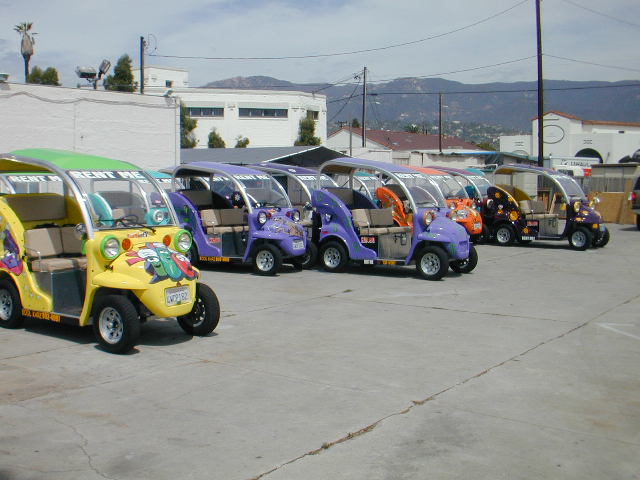
Santa Barbara, I should mention, is a particularly appropriate place for an advanced-transportation event like this, because it is a very EV-friendly city! At the rear of the line of cars at De La Guerra Plaza pictured earlier on this page you'll see a large yellow bus; this is a battery EV owned by the local transit agency, and built in town too. In the photo here are the Neighborhood EVs of "Kool Karz," which rents these low-speed vehicles to tourists; the automaker label on each was "Heartland EV," which was new to me. There were also plenty of alternative-fueled vehicles (AFVs) parked outside the hotel, including a hybrid-electric Honda Civic and a natural-gas Ford van. A city official at the Town Hall Meeting said that, with electric vehicles and rooftop solar panels, in the not-too-distant future Santa Barbara hopes to become self-sufficient in net energy use!
In conclusion, I can't help but note that I am posting this event report on the anniversary of the terrorist attacks of 11 September 2001. I have tried to keep this website as non-political as possible, given its topic; however, hearing about possible market introduction of FCVs a decade from now, I found myself reflecting on the state of alternative-fueled vehicles a decade ago. General Motors had just introduced the Impact show-car, which later became the EV1; the federal Energy Policy Act (EPACT), requiring government agencies and some private organizations to add AFVs to their fleets, had just been passed; California had just introduced its Zero-Emission Vehicle (ZEV) mandate; and the Gulf War had just been fought, reminding us of the unstable and dangerous nature of a region that supplies much of our imported petroleum. A decade later, the EV1 has been taken out of production; federal agencies have fallen far behind in their required AFV acquisitions, and environmental groups have had to bring lawsuits just to force them to assemble and publish the data on AFVs that EPACT requires them to collect; the ZEV mandate has been repeatedly weakened, and is currently in legal limbo due to automaker lawsuits; and a new war with Iraq looks increasingly likely.
On the positive side, natural-gas vehicles are becoming increasingly common in transit and other utility uses; hybrid-electric vehicles have entered the market; and at least one automaker, Toyota, has had the guts to sell full-function EVs to the public, not merely lease them. Still, I can't shake the feeling that a lot of momentum was dissipated while gasoline prices were at historic lows during the 1990s, and that a decade of opportunity to advance the causes of clean air and energy independence has been, if not squandered, then at least poorly taken advantage of. As I noted above, the automakers and energy suppliers seem to see that it is in their interests to prepare for the eventual transition from petroleum-powered to hydrogen-powered transportation; but do we really need to wait another decade for substantial market penetration of technologies that reduce petroleum use--and can we afford to wait? Or would it be better to use public education, i.e., advertising, which automakers do so well, to persuade the car- and truck-buying public to kick the petroleum habit, and to offer them a choice of already-proven AFVs to enable them to do so, before circumstances force the issue?
 Back
to AFV Events Page
Back
to AFV Events Page Back
to Fueling Station
Back
to Fueling Station Site
Map
Site
Map Contact
Me
Contact
Me All content copyright 1998-2024 by Mark Looper, except as noted. Reuse of my copyrighted material is authorized under Creative Commons Attribution 4.0 International license (CC BY 4.0).
![]()
![]()
new 11 September 2002, revised 29 April 2003